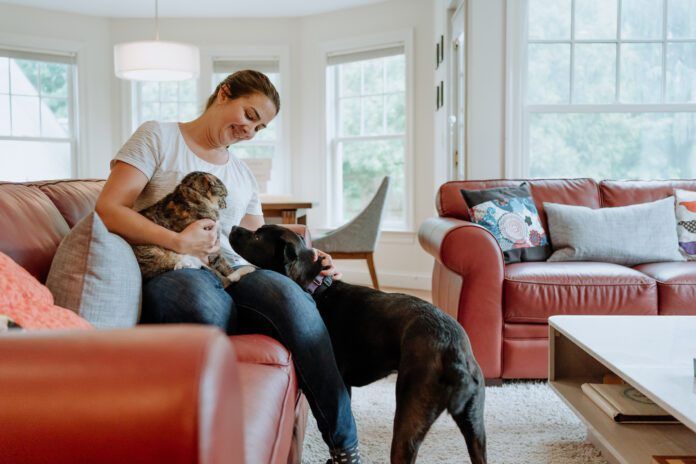There are millions of homes where cats and dogs live together in perfect harmony – mine included. How does that happen? Careful introductions of cat to dog and vice versa, good management, awareness of dog and cat body language, and patience.
A positive cat-dog relationship begins with how you introduce a cat to a dog; you don’t want to just cross your fingers! Even if you know your dogs are good with cats and this cat has lived happily with dogs in the past, the more carefully you arrange the introduction the more likely you are to set up your four-legged family members for success. Thoughtful social engineering will support your cat’s sense of safety and confidence as well as your dog’s calm acceptance of your new family member.
Here’s a cat/dog introduction protocol designed to keep all parties feeling (and in reality) safe:
- Choose a room in your home that can be securely closed to be your cat’s initial dog-free safe zone. Set up the cat’s food, water, litter box, and bed in the room. When you first bring the cat home, you will bring the cat in her carrier directly to that room.

It’s might take a while to give your cat whole-house freedom, but go ahead and prepare for that day by creating more cat-safe spaces in your home, including plenty of elevated cat-friendly surfaces, an accessible but tall cat tree, and doorways that are equipped with pet gates. While most cats can jump over pet gates, the best gates have cat-doors built into them that are too small for a dog but allow cats to run right through to safety. See “Types of Dog Gates” to learn about your many options!
- Confine your dogs to a different room – preferably a room away from the path you will travel to the cat’s room – while you bring the cat in to the house.
- Bring your cat (in her carrier) to her private room and close the door securely. Plan to keep her in this room for several days – or longer if she shows you that she needs more time. This gives her cortisol levels, heightened by the stress of a trip to a new home, a chance to settle down to normal, and gives the cat some time to acclimate to her new surroundings while also strengthening your relationship with her. Plus, it allows her to become accustomed to the scents and sounds of the dogs (outside her closed door) and gives you the opportunity to note her reaction to them.
Be sure to spend time quietly hanging out with your cat in her secure room.
- If after a few days, your cat seems confident and curious, eager to explore beyond her safe room, it’s time to introduce her to your dog in a highly controlled environment – but one that doesn’t feel restrictive or trap-like. In a large room, set up an exercise pen against a wall (this will ensure that there is a “safe side” of the pen where she can get some distance away from your dog). Put a solid or covered dog-sized carrier in the pen near the wall to give her a safe place for her to hide in the pen and cover the pen with a blanket so she can’t jump out. Place a generous handful of yummy cat treats and your cat in the pen and give her some time to explore this space. The pen will allow her to approach your dog from safety, and give her a secure retreat if she feels she needs it, without being able to run (potentially triggering a chase instinct in your dog) or hide indefinitely (which could frustrate and hinder your ability to supervise and control the next meet-and-greet attempt).
- When she has had a few minutes to investigate the pen, bring your leashed dog into the room with the pen. If you have multiple dogs, bring out the calmest, most cat-friendly one. Walk the dog slowly on leash toward the pen, watching both the cat’s and the dog’s reactions. If both seem totally calm, walk up to the pen and let them sniff. If both continue to be very calm and accepting of each other, let them hang out for a while through the barrier, then open the pen and let them be friends. You just won the cat-dog introduction lottery!
- If your cat is scared or just seems worried or the dog seems aroused, keep them a good distance apart (so stress doesn’t escalate) and sit on the floor or a chair with your dog. Feed high-value treats to your dog so he learns that the presence of the cat will cause treats to appear. He will eventually look to you for treats when the cat is present, rather than getting aroused. This is called “counter conditioning and desensitization” – giving your dog a new association with an arousing or fear-causing stimulus. Feed him a treat and then let him look at the cat, and repeat this again and again until he only glances at the cat and then quickly looks at you – or doesn’t even look at the cat at all. Now you can move closer – assuming the cat is calm, too!
If the cat is worried, a second person can drop bits of high-value kitty treats into the cat pen one at a time (this will provide counter conditioning for the cat!). This could go quickly if dog and cat are both accustomed to and comfortable and appropriate with the other species. If that’s not the case, it could take a long time.
Repeat this process with any other dogs in your household, one dog at a time.

- When your dog can remain calm and relaxed around your penned cat, with Dog #1 still on leash, open the door to the pen and invite the cat out. Do not coerce her to come out; let it be her choice. Use counter conditioning as needed to keep your dog calm while the cat walks around.
If this goes well, swap Dog #1 out for Dog #2 and so on, until all the dogs have individually interacted appropriately with the cat out of the pen. Then, try it again with a single dog and with the dog off leash (but wearing a collar so you can restrain him if necessary).
When your cat is comfortable with each dog off-leash individually, try it with two dogs, then three, until the whole family can happily hang out together. Keep those pet gates and cat trees in place, however, so the cat always has safe dog-free spaces to retreat to if she feels the need.
Management of Introducing a Cat to a Dog
Every good training and behavior program incorporates management to ensure success. With your dog(s) and cat, this means keeping them safely separated when you are not there to supervise, until you are 100% confident that they will all get along. I also recommend maintaining one room as the cat’s room (with one of those cat-door pet gates), where you continue to keep her food, bed, and litter box so she has a safe canine-free haven anytime she wants to get away from the dogs – and so your dogs don’t eat the cat food and cat poop, which dogs are very likely to do.
This seven-step process can seem cumbersome, but cat-friendly dogs and dog-savvy cats may be able to whip through it in just a day or two. Take as long as you need, however. It’s better to err on the side of caution than increase tension between your two species and sabotage your program by moving too quickly. As we like to say in behavior modification, “If you think you’re going too slow, slow down!”
If you’ve done everything described above and you are still seeing cat/dog tension, it may be time to seek the services of a qualified force-free dog-training professional. Be sure to find one who is experienced with both dogs and cats for the best results.
By the way, it is also a myth that there are “cat people” and “dog people.” There are plenty of us who love, appreciate, and share our homes with both species. And it is perfectly possible that they can all get along.
Dogs
- Barking
- Growling
- Teeth chattering
- Hard stare/intense focus
- Fast, high tail wag
- Body leaning forward
- Taking treats with a hard mouth
- Avoidance
Cats
- Hissing, growling, or yowling
- Biting
- Stillness
- Lashing out with claws
- Retreating/hiding/avoidance
- Tense, hunched body
- Flattened ears
- Skin twitching or “rippling”





